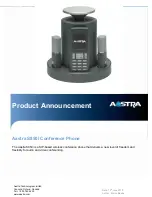
3. SIMCLK (NELL#M5)
This output connects to the SIM connector (#3). It is used to clock data to
and from the SIM card and can be switched off when not required in order
to save power.
4. SIMDT (NELL#N5 - SIMDATA)
This output connects to SIM connector (#6). All data to and from the SIM
Card is transferred along this line.
5. SIMVSEL (NELL#L3)
This control signal from NELL is used to select the operating voltage of the
SIM card. Setting the SIMVSEL high switches regulator 5 in MiniMoe to 5v
which in turn is output to the SIMVCC rail. A low switches the SIM supply to
3v.
6.6 Audio and Miscellaneous Interfaces
The audio and miscellaneous interfaces include the following:
1. Microphone
2. Ear-piece
3. Hands free Interface
4. Buzzer driver
5. Battery charging circuit
6. Vibrator
7. Simple Hands Free Interface (SHF)
6.6.1
6.6.1
Microphone
The microphone is mounted in the handset front cover and connects to the logic
board via two sprung contacts on the P5 connector. The audio signal is passed to
the logic board and to pin D4 of the P6 Simple Hands Free (SHF) socket. Inside
the socket there is a miniature switch which is closed when there is no SHF
connected. With this switch closed this allows the audio signal through to the MIC
IN (#4) pin of IC27. The voltage supply VREG is output from IC27 #3, and is a bias
voltage for both the MIC Audio path (through R156) and +TXAF lines.
See
Figure:10E. Audio and Miscellaneous Interfaces
The microphone or TXAF signal is then A/D converted by the CSP part of
Superchip (IC27). The digitised speech is then passed to the DSP section of IC27
for processing (coding, interleaving etc.). The coded speech data returns to the
CSP for GMSK modulation, D/A conversion and output as TXI and TXQ signals –
IC27 #86-89 - to the W2013 transceiver (IC100) for modulation onto the air
interface.
Summary of Contents for DB2000
Page 1: ...DB2000 Service Manual Help ...
Page 3: ... ...
Page 5: ... 2 3 4 2 2 2 2 2 0 0 0 5 3 4 2 6 2 7 2 2 2 2 0 8 9 2 2 2 2 2 2 2 2 ...
Page 7: ... 2 6 2 2 2 2 2 3 4 2 2 0 2 ...
Page 8: ... 2 ...
Page 9: ... Previous Section Next Section Main Menu Section 2 Unit Specifications ...
Page 77: ... 1 2 ...
Page 83: ...Fit Antenna INSERT AND SCREW THE ANTENNA INTO THE ASSEMBLY ...
Page 107: ...Fig 3 7 GSM_LNA Pg 3 3I TP419 Fig 3 8 PCN_LNA Pg 3 3J TP420 Fig 4 9 TCXO Pg 2 H11 TP413 ...
Page 109: ...Fig 4 3 PCN_TX Pg 1 1J TP417 Fig 4 4 3V_G_TX Pg 1 4I TP100 Fig 4 5 3V_P_TX Pg 1 4J TP101 ...
Page 110: ...Fig 4 6 GSM_ON Pg 1 2K TP402 Fig 4 7 PCN_ON Pg 1 1K TP415 Fig 4 8 PRE_ON Pg 1 4J TP416 ...
Page 112: ... I Q ...
Page 113: ...Fig 4 14 V_ERROR PCN Pwr Lvl 7Pg 1 16I Fig 4 15 300khz Charge Pump Pg 1 Log 9G ...
Page 115: ... Previous Section Next Section Main Menu Section 6 Device Device Information Information ...
Page 172: ......
Page 173: ......
Page 174: ......
Page 175: ......
Page 176: ......
Page 177: ......
Page 178: ......
Page 179: ......
Page 180: ......
Page 181: ......
Page 182: ......
Page 183: ......
Page 184: ......
Page 185: ......
Page 186: ......
Page 187: ......
Page 188: ......
Page 189: ......
Page 190: ... Previous Section Next Section Main Menu Glossary of Terms ...
















































